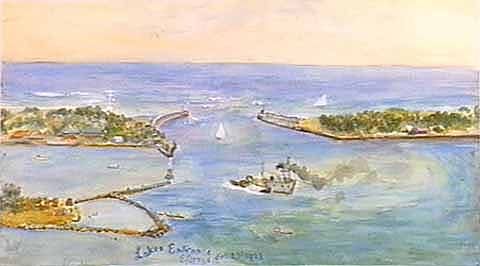The Artists
Flora Gregson
FLORA GREGSON
FROM JEMMIE'S POINT, LAKES ENTRANCE, 1923

FLORA GREGSON
Born 1854
FROM JEMMIE'S
POINT, LAKES ENTRANCE,1923
watercolour
20.3 x 37.0cm
Inscribed and
dated lower centre
'Lakes Entrance / February 26, 1923'
Collection: La Trobe Picture Collection
State Library of Victoria
Lakes Entrance is situated 319 kilometres east of Melbourne. It is a descriptive name given to this popular fishing and tourist port which stands on the east side of the narrow entrance between Bass Strait and the Gippsland Lakes, which was discovered by John Reeves in 1841.
Lakes Entrance grew from a small fishing village and port, which was originally known as Cunninghame until 1889, when a permanent entrance for shipping was completed. Members of the Cunninghame family lived in the district, and were at Clyde Bank near Sale from 1844, however it is generally accepted that the name of the town was derived from R.A.C. Cunninghame of Maneroo.
The Ganay Aborigines are thought to have occupied the area before European settlement.
This watercolour by Flora Gregson provides us with a view to the south east, and through the entrance to Bass Strait. The Cunninghame Arm opens off the entrance to the middle left in the painting, and runs parallel to the sand dunes and surf beach on one side and where Princes Highway is today, on the other. Today a footbridge across the arm gives access to the 'children's beach' and to the surf beach.
The land jutting out in the left corner of this work is Bullock Island that lies across the entrance of Cunninghame Arm and North Arm. This island is now connected to the mainland by a bridge The North Arm is the main boat launching area, over which you now drive along Princes Highway to the town centre, which sits between Cunninghame and North Arms.
This watercolour was painted from the picturesque Jemmie's point, which is still today a popular photographic stopping point for tourists, situated a short distance west of the township.
The point is known as Jemmie's Point or Jemmy's Point or Jimmy's Point, and is part of what was once known as Mount Barkly. The point was named after the Aboriginal, Jimmy Gibber who travelled with explorer, Angus McMillan in 1839. In May 1839, McMillan began his first expedition of Gippsland and reached the site of Omeo on 11 June 1839. The following year on 11 January 1840, McMillan and his party set off from the Tambo River to explore into Gippsland, and on 16 January 1840, discovered Lake Victoria (Lake King), the Nicholson River (17th), the Mitchell (18th) and the Avon and Macalister Rivers on the 22nd. In 1841, McMillan set off on 9 February on a five-day expedition to Port Albert (near Corner Inlet). McMillan died on 18 May 1865, aged 54.
This watercolour also depicts the two substantial piers built on either side of the entrance, and a steamer in the main channel heading west through The Narrows towards Kalimna Cove and Jetty and further afield to the far reaches of the Gippsland Lakes and Sale.
Another channel, named Hopetoun Channel is to the right of this painting, between the sand dunes to the right and the large Rigby Island, just out of picture to the middle right.
The interconnected Gippsland Lakes, which are an extensive and sensitive estuarine system, stretch for 80 kilometres parallel to the Ninety Mile Beach, and are separated from the sea by a narrow line of sand dunes.
The Gippsland Lakes district and Lakes Entrance in particular owes a degree of its development to the discovery of oil, and not just off shore.
In 1924, Australia's first discovery of oil was made at Lake Bunga. Lake Bunga, which is situated a short distance to the east of Lakes Entrance, derived its name from the Aboriginal term 'bung' for creek In 1965, an off shore drilling-rig discovered commercial quantities of natural gas in Bass Strait. Today the field is a major producer of Australia's crude oil requirements, and Lakes Entrance is considered the 'service centre for the off shore Bass Strait oil and natural gas operations'.
Lakes Entrance is also known for its tourism, its forestry industry and its fishing, especially its scallop fishing fleet.
Little is known of the artist who produced this work. Records located so far have the following. Flora Gregson, nee Minter, born 1854. Watercolour painter, who produced watercolour views of the Geelong and Gippsland Lakes districts. Many of her watercolour works of Lakes Entrance and the Gippsland Lakes are now held in the Picture Collection, La Trobe Library, State Library of Victoria.
Andrew Mackenzie
Copyright
Notice
No works
can be copied from this site. Permission to publish or reproduce can be
sought from the
State Library of Victoria.
All Rights Reserved medialaunch Pty. Ltd.
Left: Arthur
Streeton - Above Us The Great Grave Sky, 1890
Collection: National Gallery of Australia, Canberra.
ABN 69 067 524 921
Tel: +61 3 98185700 Fax: +61 3 98185044
Email: editor@artistsfootsteps.com